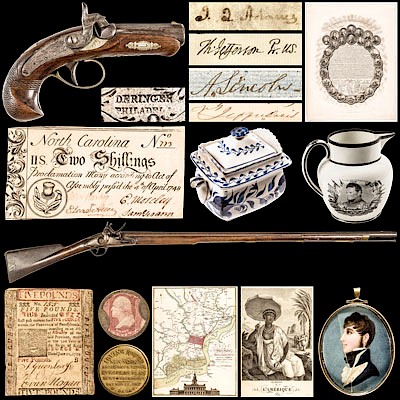Thomas Wentworth Higginson the 33rd U.S. Colored Troops 1st Black U.S. Army Regt
Lot 48
Categories
Estimate:
$300 - $400
Absentee vs Live bid
Two ways to bid:
- Leave a max absentee bid and the platform will bid on your behalf up to your maximum bid during the live auction.
- Bid live during the auction and your bids will be submitted real-time to the auctioneer.
Bid Increments
| Price | Bid Increment |
|---|---|
| $0 | $10 |
| $200 | $20 |
| $300 | $25 |
| $500 | $50 |
| $1,000 | $100 |
| $2,000 | $200 |
| $3,000 | $250 |
| $5,000 | $500 |
| $10,000 | $1,000 |
| $20,000 | $2,000 |
| $30,000 | $2,500 |
| $50,000 | $5,000 |
| $100,000 | $10,000 |
| $200,000 | $20,000 |
| $300,000 | $25,000 |
| $500,000 | $50,000 |
About Auction
By Early American History Auctions
Oct 19, 2019
Set Reminder
2019-10-19 12:00:00
2019-10-19 12:00:00
America/New_York
Bidsquare
Bidsquare : Historic Autographs-Currency-Political-Americana-Militaria-Guns
https://www.bidsquare.com/auctions/early-american-history-auctions/historic-autographs-currency-political-americana-militaria-guns-4513
326 Lots of Rare, Historic Autographs, Americana, Civil War Era, George Washington, Abraham Lincoln, Black History, Revolutionary War Era, Colonial America, Federal Period, War of 1812, Colonial Currency, Indian Peace Medals & more... Early American History Auctions auctions@earlyamerican.com
326 Lots of Rare, Historic Autographs, Americana, Civil War Era, George Washington, Abraham Lincoln, Black History, Revolutionary War Era, Colonial America, Federal Period, War of 1812, Colonial Currency, Indian Peace Medals & more... Early American History Auctions auctions@earlyamerican.com
- Lot Description
Autographs
Thomas Wentworth Higginson Commanded the 33rd U.S. Colored Troops the first Black U.S. Armed Forces Regiment
THOMAS WENTWORTH HIGGINSON (1823-1911). Commanded the 33rd U.S. Colored Troops, the first Black Regiment in the U.S. Armed Forces.
Undated, 4" x 2.25" Inscription and Signature, "For Miss Helen McDonnell / Thomas Wentworth Higginson / Cambridge, Mass," Very Fine. Prior mounting remnants on the blank reverse. On the passage of the Fugitive Slave Act (1850), Higginson joined the Boston Vigilance Committee to aid escaping slaves. While pastor of a "Free Church" in Worcester, Massachusetts (1852-1861), he took a leading part in liberating the fugitive Anthony Burns (1854), and he supported John Brown both in Kansas (1856) and in his raid on Harpers Ferry, Virginia (1859). Scarce.
THOMAS WENTWORTH HIGGINSON (1823-1911). Ordained after graduating from Harvard Divinity School (1847), Higginson became pastor of the First Religious Society of Newburyport, Massachusetts, where he preached a social gospel too liberal even for Unitarians. Two years later his progressive views on temperance, women's rights, labor, and slavery caused him to lose his congregation.
On the passage of the Fugitive Slave Act (1850), Higginson joined the Boston Vigilance Committee to aid escaping slaves. While pastor of a "Free Church" in Worcester, Massachusetts (1852-1861), he took a leading part in liberating the fugitive Anthony Burns (1854), and he supported John Brown both in Kansas (1856) and in his raid on Harpers Ferry, Virginia (1859).
During the early part of the Civil War, Higginson was a Captain in the 51st Massachusetts Infantry from November 1862 to October 1864, when he was retired because of a wound received in the preceding August. He accepted command as Colonel of the First South Carolina Volunteers, later the 33rd U.S. Colored Troops, the first Black regiment in the U.S. armed forces, the first authorized regiment recruited from freedmen for Union military service. Secretary of War Edwin M. Stanton required that black regiments be commanded by white officers.
After 1864, he wrote a series of popular biographies and histories and a novel. Higginson described his Civil War experiences in Army Life in a Black Regiment (1870). He contributed to the preservation of Negro spirituals by copying dialect verses and music he heard sung around the regiment's campfires.
In his book, Drawn by the Sword: Reflections on the American Civil War (New York: Oxford University Press, , 1996), historian James M. McPherson asserted that Higginson's service as a Union soldier showed in part that he did not share the "powerful racial prejudices" of others during the time period.
- Shipping Info
-
Early American provides in-house worldwide shipping. Please contact us directly if you have questions about your specific shipping requirements.
-
- Buyer's Premium



 EUR
EUR CAD
CAD AUD
AUD GBP
GBP MXN
MXN HKD
HKD CNY
CNY MYR
MYR SEK
SEK SGD
SGD CHF
CHF THB
THB












